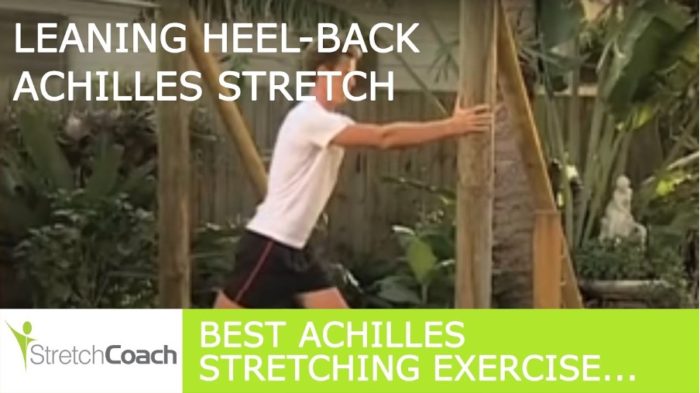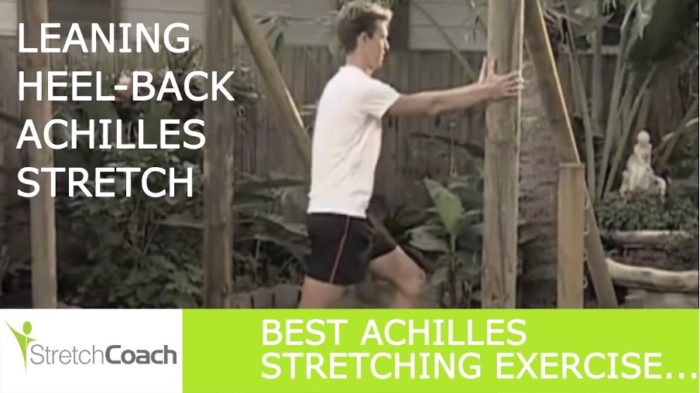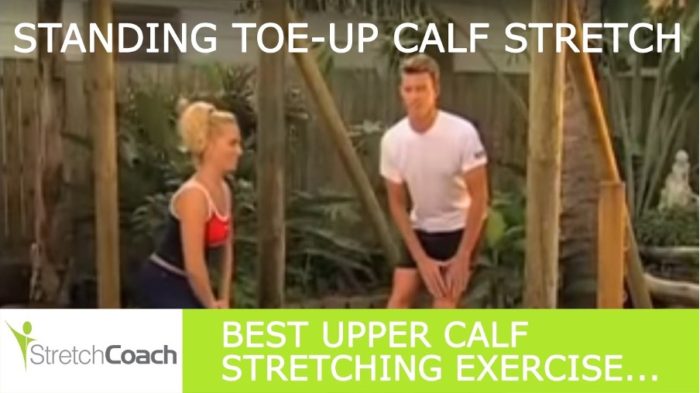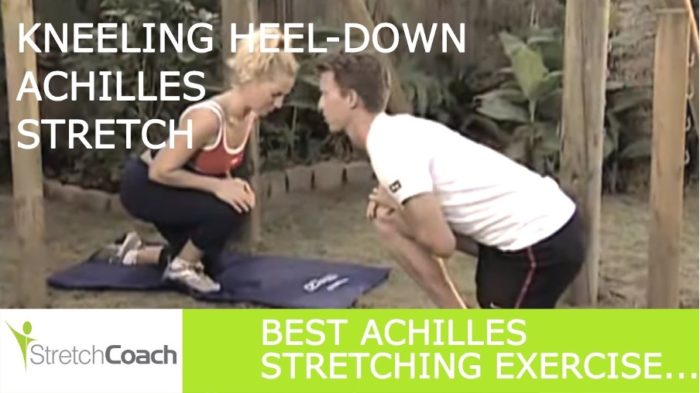Achilles Problems, Part 2
Last issue, Brad Walker talked us through treating Achilles injuries. This month Brad continues with the six best calf and Achilles stretches and exercises that will reduce injuries in the first place.
You can meet Brad on Monday morning May 20 at 9.30am BST when he is running a webinar for ThinkTree on “Mythbusting stretching – the science behind stretching”
Calf and Achilles stretches are important for the flexibility and range of motion of the lower leg and foot muscles. Good calf and Achilles flexibility allows for unrestricted, pain free movement of the lower leg, foot and ankle, and as you can see from the research below, is vital for reducing the incidence of lower limb injuries.
Research
“Poor dorsifexion ROM (ankle flexibility) was associated with 2.5 times the risk of lower limb injuries compared with average dorsifexion ROM and 8 times the risk compared with people with a high level of flexibility.”
- Gabbe, B. Finch, C. Wajswelner, H. Bennell, K. (2004) Predictors of Lower Extremity Injuries at the Community Level of Australian Football. Clinical Journal of Sport Medicine, 14(2):56-63.
- Pope, R. Herbert, R. Kirwan, J. (1998) Effects of Ankle Dorsiflexion Range and Pre-Exercise Calf Muscle Stretching on Injury Risk in Army Recruits. Australian Journal of Physiotherapy, 44(3):165-172.
Sports that Benefit from Calf and Achilles Stretches
Sports that benefit from the calf and Achilles stretches below include: Running, Walking, Race Walking, Track, Cross Country, and all running sports like Soccer, Football, Gridiron, and Rugby. Basketball, Netball, Ice Hockey, Field Hockey, Ice Skating, Roller Skating, Inline Skating, Martial Arts, Snow Skiing, Water Skiing, Surfing, and any sport that involves jumping or explosive movement. Cycling, Hiking, Backpacking, Mountaineering and Orienteering also benefit from regular calf and Achilles stretching .
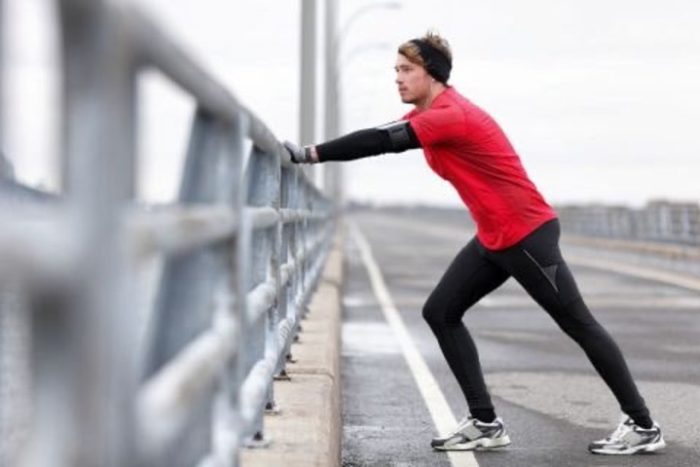
Calf and Achilles Muscles being Stretched
While performing the calf and Achilles stretches below there are a number of muscles within the lower leg that are stretched. Below is a comprehensive list of the anatomical muscle names involved in the following stretches.
- Gastrocnemius (Upper calf);
- Tibialis Posterior (Upper calf);
- Flexor Digitorum Longus and Flexor Hallucis Longus (Upper calf);
- Soleus (Lower calf and Achilles);
- Peroneus Longus and Peroneus Brevis (Lower calf and Achilles); and
- Semimembranosus, Semitendinosis and Biceps Femoris (Hamstring).
Calf and Achilles Stretching Safety Guidelines
As with all exercise activities there are rules and guidelines to ensure that they are safe. Stretching is no exception. Stretching can be extremely dangerous and harmful if done incorrectly. It is vitally important that the following guidelines be adhered to, both for safety and for maximizing the potential benefits of stretching.
- Always warm-up before performing any calf stretching exercises.
- Breathe. Don’t hold your breath. Holding your breath causes muscle tension and can raise your blood pressure. The deeper you breathe, the more relaxed your muscles will be, and the deeper and longer you will be able to stretch.
- Never push a stretch beyond the point of mild discomfort. Stretching tight muscles can be uncomfortable, but you should never feel any sharp or sudden pain. If you do, stop immediately; you are pushing the stretch too far.
- Be consistent. Stretching for a few minutes a couple of times a day will gradually build flexibility and range of motion. This is a better way to stretch, rather than only once a week for a longer time.
- Wear loose comfortable clothing. It’s obviously very difficult to stretch if your clothes are tight and restrict movement.
Sample Calf and Achilles Stretches
Slowly move into the stretch position until you feel a tension of about 7 out of 10. If you feel pain or discomfort you’ve pushed the stretch too far; back out of the stretch immediately. Hold the stretch position for 20 to 30 seconds while relaxing and breathing deeply. Come out of the stretch carefully and perform the stretch on the opposite side if necessary. Repeat 2 or 3 times.
Important: To stretch the calf and Achilles effectively it’s important to stretch with both a straight leg and a bent leg. Stretching with a straight leg will emphasize the upper calf, while stretching with a bent leg will emphasize the lower calf and Achilles.
Double Heel-drop Calf Stretch: Stand on a raised object or step. Put the balls of both feet on the edge of the step and keep your legs straight. Let your heels drop towards the ground. Hold this stretch for about 20 to 30 seconds and repeat at least 2 to 3 times.

Single Heel-drop Achilles Stretch: Stand on a raised object or step and place the ball of one of your feet on the edge of the step. Bend your knee slightly and let your heel drop towards the ground. As above, hold this stretch for about 20 to 30 seconds and repeat at least 2 to 3 times on each side.
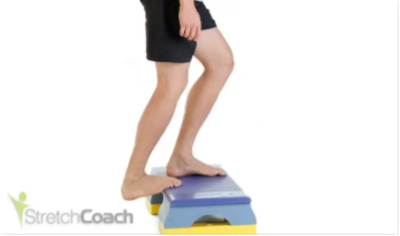
Sample Calf and Achilles Stretching Videos
Below you’ll find a few good stretches for your calves and Achilles. But don’t rely on just a few stretches; it’s important to do a range of stretches for the buttocks, hamstrings and groin. Please be careful, if you haven’t stretched your calf and Achilles muscles, some of these stretches will put a lot of stress on the muscles and tendons. Warm-up first, then proceed in a gradual and gently way.
Leaning Heel-Back Calf Stretch (1:19) Stand upright and lean against a wall. Place one foot as far from the wall as is comfortable and make sure that both toes are facing forward and your heel is on the ground. Keep your back leg straight and lean towards the wall. Make sure the toes of your back leg are facing forward. Letting your toes point to one side will cause this stretch to put uneven tension on the calf muscles. Over an extended period of time, this could lead to a muscle imbalance. Hold the stretch position for a minimum of 20 seconds and then repeat with the opposite leg.
Leaning Heel-Back Achilles Stretch (1:17) Stand upright while leaning against a wall and place one foot behind the other. Make sure that both toes are facing forward and your heel is on the ground. Bend your back leg and lean towards the wall. Make sure the toes of your back leg are facing forward. Letting your toes point to one side will cause this stretch to put uneven tension on the calf muscles. Over an extended period of time, this could lead to a muscle imbalance. Regulate the intensity of this stretch by lowering your body. Hold the stretch position for a minimum of 20 seconds and then repeat with the opposite leg.
Standing Calf Stretch (1:20) Stand with one knee bent and the other leg straight out in front. Point your toes towards your body and lean forward. Keep your back straight and rest your hands on your bent knee. Make sure your toes are pointing upward. Letting your toes point to one side will cause this stretch to put uneven tension on the calf muscles. Over an extended period of time, this could lead to a muscle imbalance. Hold the stretch position for a minimum of 20 seconds and then repeat with the opposite leg.
Kneeling Achilles Stretch (1:27) Kneel on one foot and place your body weight over your knee. Keep your heel on the ground and lean forward. This stretch can put a lot of pressure on the Achilles. Ease into this stretch by slowly leaning forward. Hold the stretch position for a minimum of 20 seconds and then repeat with the opposite leg.
What’s the best excuse you ever had for a client ‘no show’? “I found a chihuahua in the middle of the road” has to be one of the best or “My finger got stuck in the ATM”. Often, according to social media rants, it’s simply “I forgot”.
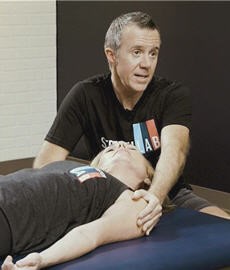
About the Author: Brad Walker is often referred to as the “Stretch Coach” and has even been called the Stretching Guru. Magazines such as Runners World, Bicycling, Triathlete, Swimming & Fitness, and Triathlon Sports have all featured his work. Amazon has listed his books on five Best-Seller lists. Google cites over 100,000 references to him and his work on the internet. And satisfied customers from 122 countries have sent 1,000’s of verified customer reviews. If you want to know about stretching, flexibility or sports injury management, Brad Walker is the go-to-guy.
Email: contact@stretchcoach.com
Website: https://stretchcoach.com/
To grab a copy of Brad’s Ultimate guide to stretching and flexibility, go here.
